Harnessing Shades and Motorized Controls to Enhance Occupant Well-Being
Shading systems are traditionally presented, first and foremost, as a method to achieve energy cost savings by using natural light and solar heat gain control to lower utility bills and reduce the size of HVAC and lighting systems. While the impact of shading strategies on energy is demonstrable and more easily measurable, one of their greatest impacts is on occupant welfare, and this becomes a definitive advantage.
In modern commercial buildings, the largest amount of money spent annually on operation is invested in people. Wages and other workforce costs represent the biggest chunk of operating expenses, and it is in this area where shading solutions can have the greatest impact.
According to the Productive section of the WBDG, typical total life-cycle costs of private-sector buildings are $200 per square foot per year for salaries; $20 for amortized bricks/mortar cost; and $2 for energy.5 Based on these numbers, even a very small improvement in worker productivity and welfare will have a huge impact. “Buildings can be a more effective, exciting places to work, learn, and live by encouraging adaptability, improving comfort, supporting sense of community, and providing connections to the natural environment, natural light, and view,” the WBDG states.
The WBDG designates five basic design principles that are part of productive buildings:
- The design promotes health and well-being.
- The design accommodates the changing workplace.
- The design integrates technological tools.
- The design assures reliable systems and spaces.
- The design promotes comfortable environments.
If the majority of building expenses is related to occupants, increasing occupant comfort and productivity is vital, not only for the occupant but also for the building in the long term. How then can the design professional measure the success of various shading strategies? How can occupant welfare be measured numerically? A business’s productivity can be evaluated at a high level by dividing revenue (earnings before interest, taxes, depreciation, and amortization, or EBITDA) by the number of employees. In manufacturing, productivity is easily measured by dividing production output (widgets made) by production input (labor hours). In office environments, productivity can be much harder to measure. Researchers in occupant welfare and productivity frequently use metrics like absenteeism, employee satisfaction, and retention/turnover to gauge an effect on productivity.
Indoor environmental quality can be characterized by four main dimensions: thermal, visual, acoustic comfort, and IAQ. Using these factors as a guide, window shades have a verifiable impact on improving productivity and occupant welfare.
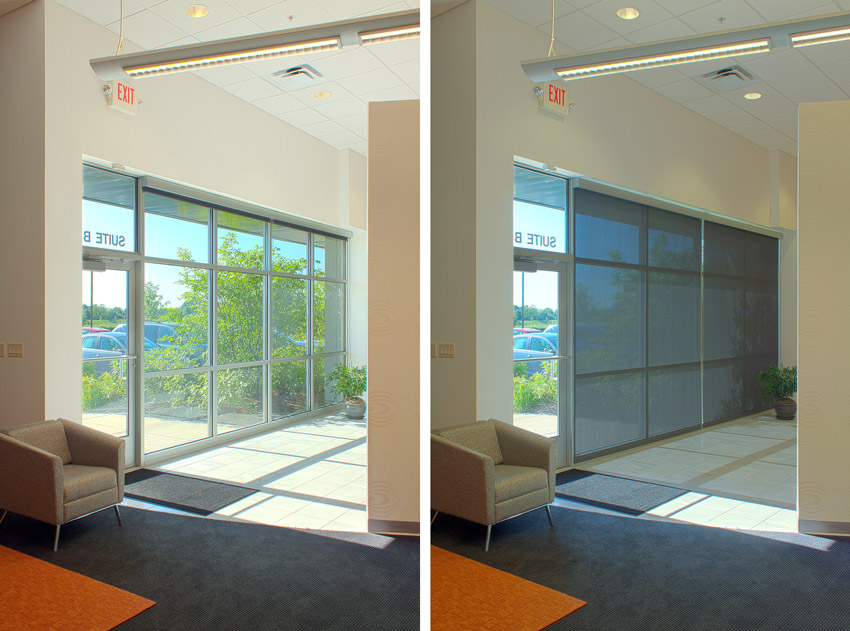
Photos courtesy of Draper Inc.
Visual stress is a crucial issue for commercial buildings. Shades create healthy levels of light for occupants while preserving views to the outside.
The Impact of Shades on Occupant Welfare: Preserving Visual Comfort
Paramount to occupant welfare is availability of natural light. The human body needs natural light to create enzymes and proteins for a healthy life.
A 2003 study by the California Energy Commission (CEC) found that daylight levels and ventilation rates had a statistically significant impact in several occupant welfare models tested.6 Indoor environmental conditions demonstrated a measurable relationship to changes in office worker performance.
Having an effective electric lighting system does not replace the human need for natural light. A 1994 study found a statistically significant improvement in job performance in offices with windows. The Center for Building Performance and Diagnostics at Carnegie Mellon University looked at the impact of daylighting on productivity and recorded 40 percent gains. Evidence also suggests that workers make fewer mistakes in environments with plenty of natural light.
Therefore, natural light—and the means of getting it into a building—becomes an essential part of designing a building, not just to save on energy but also for maximum occupant productivity. The full benefits of natural light, however, stretch beyond the light itself. Access to window views of the outside also gives workers a connection to nature, which has also been found to have an impact on mood, satisfaction, and performance. On average, major health complaints are between 20–25 percent lower for persons close to an exterior window versus those that work in the interior core of a building, without access to view and daylight.7 Access to windows and daylight resulted in a 15 percent reduced absenteeism.8 Office workers were found to perform 10–25 percent better on tests of mental function and memory recall when they had the best possible view versus those with no view.
However, the incorporation of more windows into building design can bring negative consequences for occupants too. CEC found that windows are perhaps one of the most complex aspects of the office environment. While they can provide an office with daylight, views, ventilation, and a communication conduit with the outside world, windows also create an avenue for thermal discomfort, glare, noise, and distractions in the workplace.
Glare and direct sun on workers’ eyes or workspaces makes it harder to perform basic work functions and actually lowers productivity.
According to the American Optometric Association, the National Institute for Occupational Safety and Health, the Illumination Engineering Society (IES), the Human Factors Society, General Electric Corp., and other authorities, the average office environment requires only 20–70 foot-candles (fc) of light to perform computer and computer/paper tasks. Yet, in stark contrast, most work sites measure 80–120 fc of light. Vision-related problems are reported by a majority—between 61–80 percent—of those who work on computers for 6 or more hours per day.
Visual stress on occupants is a crucial issue for commercial buildings. The Occupational Safety and Health Administration (OSHA) workplace guidelines recognize the debilitating effects of glare causing eye strain, tension, lower productivity, and loss of visual function on electronic screens. The 2003 CEC study showed that the greater the glare potential from primary view windows, the worse the office worker performance, decreasing productivity by 15–21 percent, all other things being equal.
If bright, glary lighting is present, occupants tend to squint their eyes, causing facial muscles to contract. Over the course of the day, this can lead to tension headaches, eyestrain, and visual fatigue.
Because of their unique characteristics, solar shades play an important role in balancing the benefits of daylight and outdoor views against the negative consequences from glare and visual strain.
The flexible characteristics available with solar shade applications help commercial spaces to resolve occupant discomfort from all types of glare, including direct, high contrast ratio, and reflective glare. When the sun is relatively low in the sky and aligns directly with a window elevation, shade fabric density alleviates the direct disk glare generated by the sun’s angle. High contrast ratio glare occurs when the area behind an occupant’s work surface is much brighter than the actual work surface. Shades resolve this contrast ratio by using darker color tones and avoiding colorways with white yarns. Reflective glare caused by a light or bright light source reflecting directly on a worksurface can be reduced by selecting a dark-colored shade fabric. Performance shade fabrics can reduce glare by 70–100 percent, based on color, openness factor, and building orientation, while preserving view through.
Including automated shading optimizes glare control and maximizes daylighting based on building orientation and exterior conditions. Sensors measure and balance exterior light levels with desk illuminance to precisely control the shades, allowing for mitigation of glare and permitting light adjustments, as necessary, to provide adequate work surface illumination.
Glare control during the day is a pivotal reason for window shade use. However, shades can also play a role when the sun goes down. Light pollution can disrupt ecosystems and have adverse health effects on people, animals, and plants. The best way to drastically reduce light pollution is with opaque fabrics. A LEED credit is available for automated shading systems that reduce a building’s nighttime visible light transmission (VLT) to less than 10 percent. The system must be automated/scheduled to qualify for this credit.
Since every building type, design, and location is different, there is no one-size-fits-all solution. There are many types of systems and fabrics that can be used. Whichever type of solution is required, having a system that can react according to the prevailing conditions is important. Local control can be retained to promote individual comfort; however, this can negate all of the other benefits of automation.
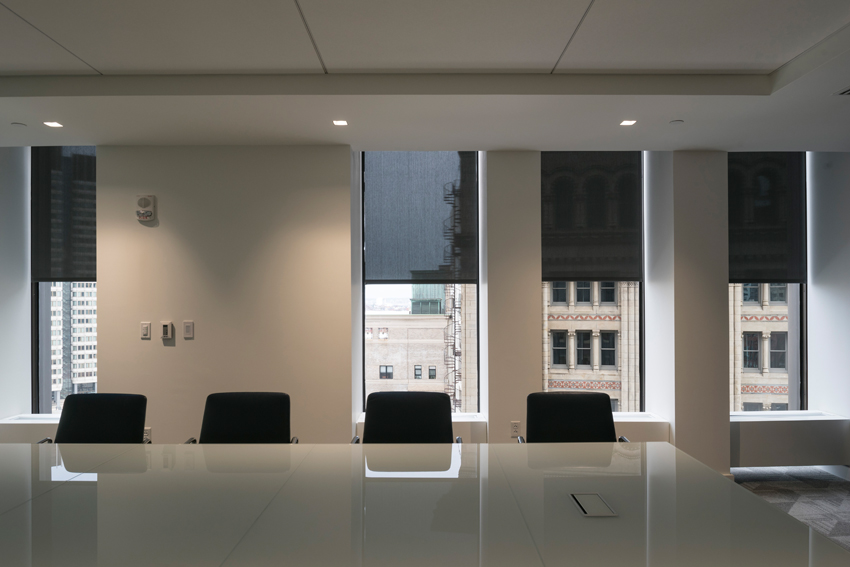
Photo: © Brett Drury, Architectural Photography
Solar shades absorb the energy at the perimeter of the building and, via radiation, allow the heat to rise directly up instead of affecting thermal comfort of people further inside the space and creating additional heat buildup by striking more surfaces. By reflecting solar energy away, rather than transmitting it into the building, shades deflect heat transmittance.
Windows play an integral role in buildings by providing daylighting and ventilation. This role is clearly demonstrated by data, with numerous studies finding that the health, comfort, and productivity of building occupants are improved due to well-ventilated indoor environments and access to natural light. The very sustainability of a building itself—how much energy it consumes and the health of its interior and exterior structures—can be further enhanced by careful fenestration design.
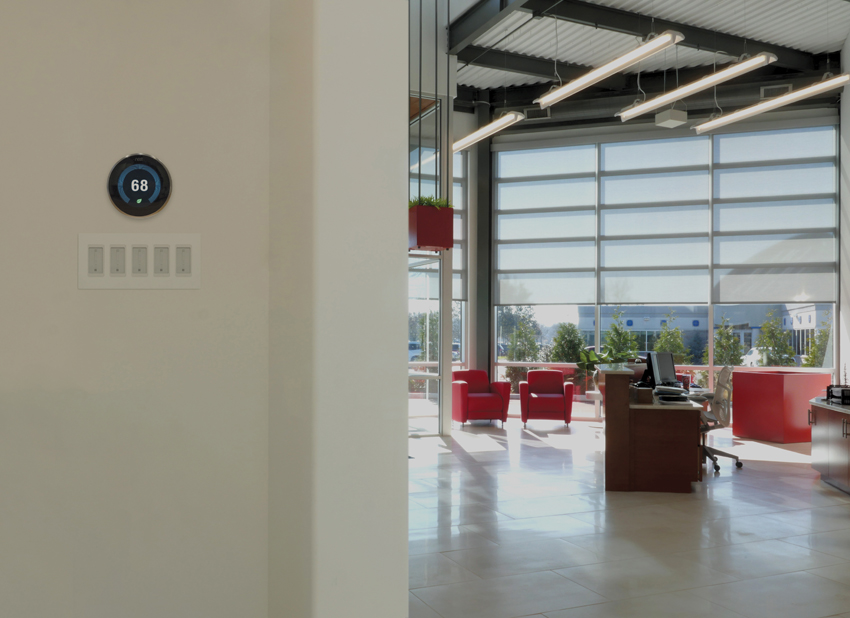
All images courtesy of Draper Inc.
Windows are pivotal in today’s commercial spaces. The higher percentage of glass also raises the stakes for shading strategies.
However, these benefits carry a price: Gregg D. Ander, FAIA, Whole Building Design Guide, cautions that windows also represent a major source of building issues, including unwanted heat loss and/or heat gain, discomfort, and condensation.1 In turn, these problems directly impact occupant comfort and productivity as well as the overall building performance.
A successful shading product and plan mitigate the negative issues arising from increased glazing surfaces, while still allowing the building and occupants to enjoy the benefits. Motorized shade systems create ideal environments to promote occupant well-being and increase energy savings. Unlike other shading strategies, natural light can be maximized, energy conserved, and thermal comfort maintained simply through the proper specification of motorized shades and controls. A motorized and automated shade system provides the greatest advantage to the design for a relatively small cost impact on the overall project budget—an expense that can ultimately be offset by improved occupant productivity and energy cost savings.
Comparing Today’s Shading Strategies
Modern windows have undergone a high-tech transformation. With technology advancing in huge strides, even from the fenestration of just 10 years ago, today’s glazed units are high-performance, energy-efficient systems that dramatically cut energy consumption and pollution sources. According to the National Institute of Building Sciences’ Whole Building Design Guide (WBDG), glazing advances in modern windows stack up to lower heat loss, cut air leakage, and create warmer window surfaces that improve comfort and minimize condensation.
While technology has resolved some of the outstanding energy concerns with fenestration, glare, solar heat gain, and direct sunlight on occupants’ eyes or workspaces still can diminish the comfort of interior spaces, making it more difficult to perform basic work functions and endangering occupant comfort.
Solar control, a shading strategy, is therefore of paramount importance in the modern commercial building. Because every building type, design, and location is different, there is no one-size-fits-all solar-control solution.
Architects and designers find that many approaches to solar control are available to them. Chief among these options are fixed exterior shading, mini blinds, dynamic glass, and interior solar shades. Whichever type of solution is selected, having a system that can react according to the prevailing conditions, while retaining local control so that individual comfort is taken into account, is important.
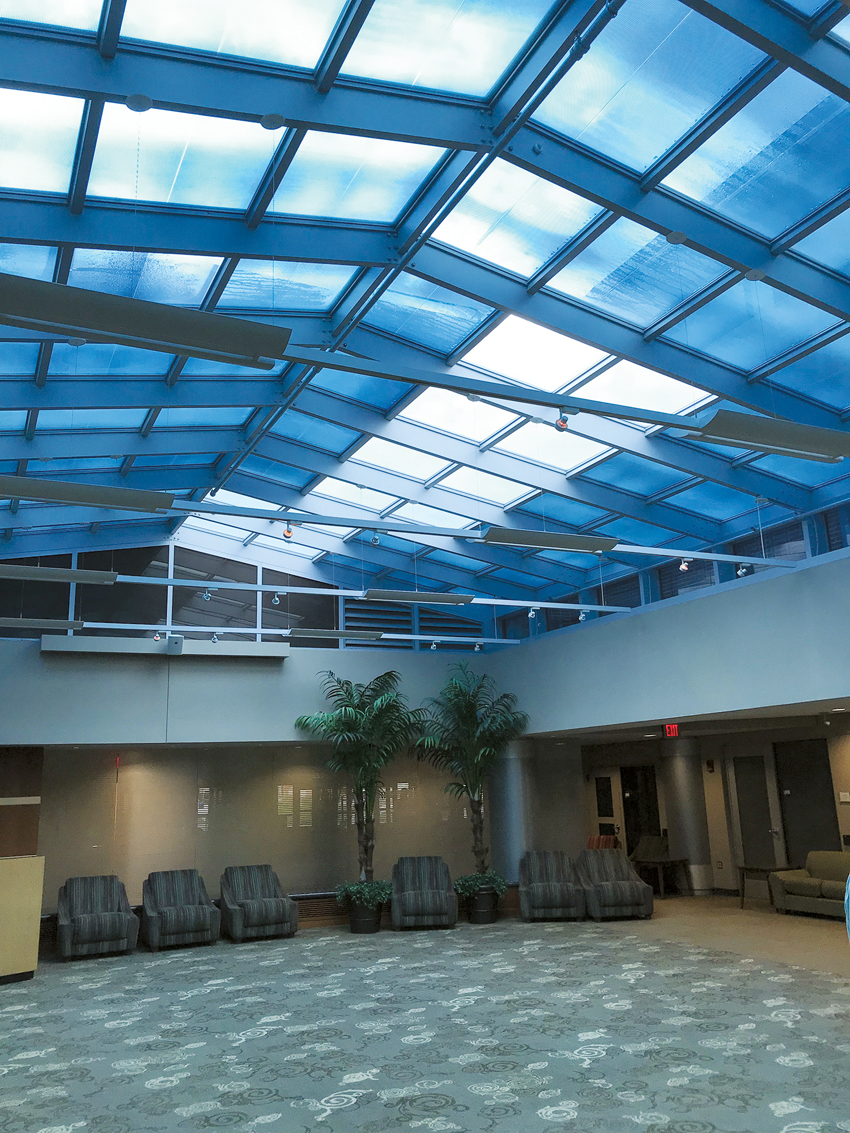
Dynamic glazing offers a new option for shading in buildings, but it is expensive and difficult for retrofit applications.
Fixed Exterior Shading
Fixed exterior shading structures allow for dramatic aesthetic expressions that highlight building architecture. Typically, fixed exterior structures are used to create overhangs that shade windows beneath, which in turn reduce solar heat gain.
However, fixed exterior shade strategies cannot react to changing sky or sun conditions and, practically speaking, can only be effective for southern elevations in the Northern Hemisphere. Eastern and western elevations with low-angle sun exposure are impractical for most exterior shading devices. Generally, these windows will still require interior shading to reduce glare and provide occupancy comfort. To be effective, fixed exterior shades can also be extremely expensive, depending on the material selected.
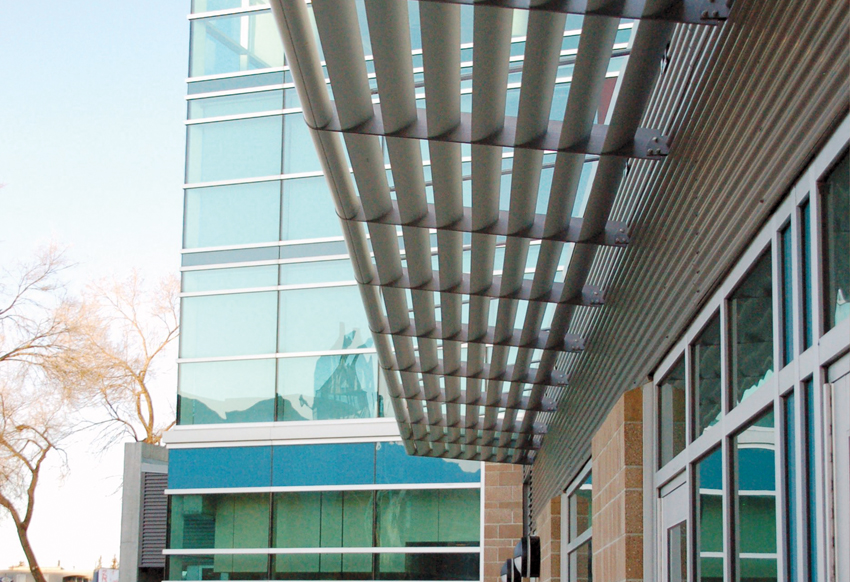
Fixed exterior shading creates an often striking but non-flexible solar shading option for buildings.
Dynamic Glass
One of the newest mainstream technologies for shading is dynamic glass. Dynamic glass uses electricity to alter the chemical composition of the glass or coating to shift window tints in response to the sun’s angle or via a switch control. While dynamic glass preserves views, it is expensive and, in certain cases, can be slow to respond to changing exterior conditions. Windows can present an inconsistent color, particularly across a large facade. Dynamic glass can be difficult to retrofit and is often unsuitable for existing multi-tenant buildings. In addition, if true privacy is desired, other treatments may need to be incorporated.
Mini Blinds
One-inch horizontal blinds, or mini blinds, are a conventional solution that are available off the shelf for a minimum cost. Mini blinds can be adjusted for glare control and to allow for personal interaction, but closing the blinds to prevent glare sacrifices both view and natural daylight.
Mini blinds are high maintenance, requiring frequent cleanings to eliminate the buildup of airborne dust and potential pathogens. Frequent adjustment increases damage to slats, wands, and lift cords and requires extensive attic stock, forcing building management to maintain replacement materials in a wide range of sizes. Mini blinds have an operational life of six to eight years.
Solar Shades
Solar shades are designed to preserve views of the outside and allow natural light to enter a room while controlling unwanted glare. When not in use, solar shades simply roll up and out of the way—whether into a recess in the ceiling or a set point on the window or wall. Besides glare control, shades offer heat control and ultraviolet (UV) light protection. There are many types of shade systems, from manual to fully automated, and many fabrics options, depending on the project requirements.
Solar shades are flexible and allow for unique responses to changing conditions, optimize orientation and occupancy, and are durable. Manually operated solar shades can be operated by a bead chain clutch, crank operation, or spring rollers.
Motorized or automated shades are a relatively inexpensive upgrade within shade technology and allow for better control and maximal benefit realization for occupant welfare and energy efficiency. Average expected operational life for shades is 25-plus years. Shade fabric weave, color selection, and openness affect building temperature, glare, and visual comfort.
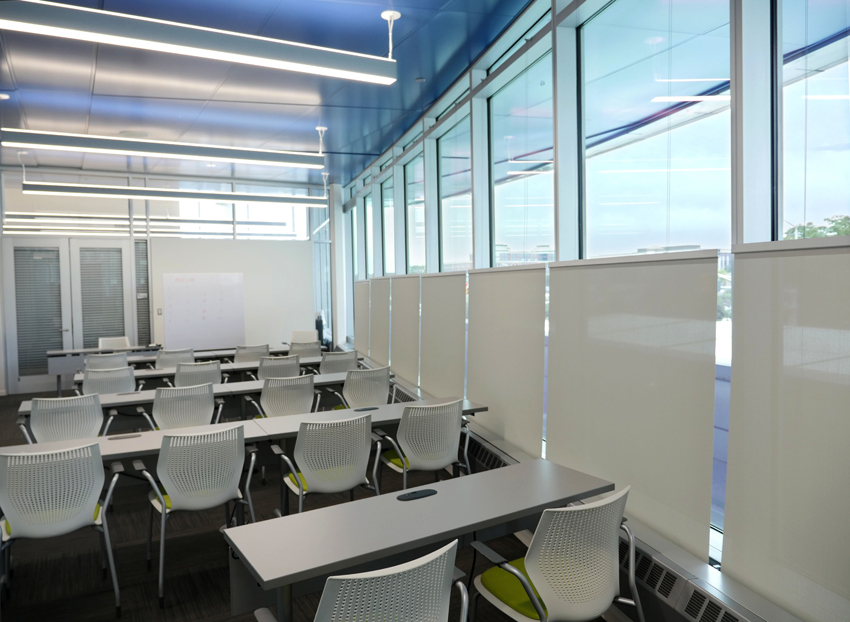
Photo courtesy of Draper Inc.
Solar shades are designed to offer designers optimum control of glare, heat, and UV protection.
Weave
The even spaces in a two-by-two basketweave make it easier for the eye to focus through the fabric, preserving views. Linear weaves break up the view, providing privacy for occupants. Twill weaves create duplex fabrics with distinguishable room and street sides.
Color
Fabrics are either broadly classified as light-colored fabric, dark-colored fabric, or duplex fabric. Light-colored fabric shades are more reflective to provide better thermal comfort. However, the reflective characteristics of light colors also make viewing through the shade more difficult and may offer less glare control. Dark-colored shade fabrics absorb more heat and then radiate heat into the room. These fabrics offer better glare control and view through but less thermal comfort than light fabrics. Duplex fabrics are a single fabric with one light side and one dark side to balance thermal comfort, glare control, and view through. A lighter, reflective surface faces the exterior for thermal comfort and energy savings, and a darker comfort surface faces the interior, providing glare control, view-through capability, and UV protection.
Openness
Fabric color works hand-in-hand with openness factor. Openness factor is the percentage of space between the yarns in the weave. The smaller the openness factor, the less light gets through. The higher the openness factor, the more space there is between yarns. A higher openness factor will typically produce better view-through characteristics. However, that also means more solar radiation getting through into the room.
Openness factor is especially important in reducing glare. Combining a smaller openness with a darker color provides glare control with better view-through characteristics.
Motorized shades add either individual or automated controls to maximize energy efficiency and occupant comfort. When fully automated, motorized shade systems remove the necessity for human interaction to maintain comfort. They also offer the opportunity to create a consistent exterior appearance, facilitate timed events, or augment seasonal building performance.
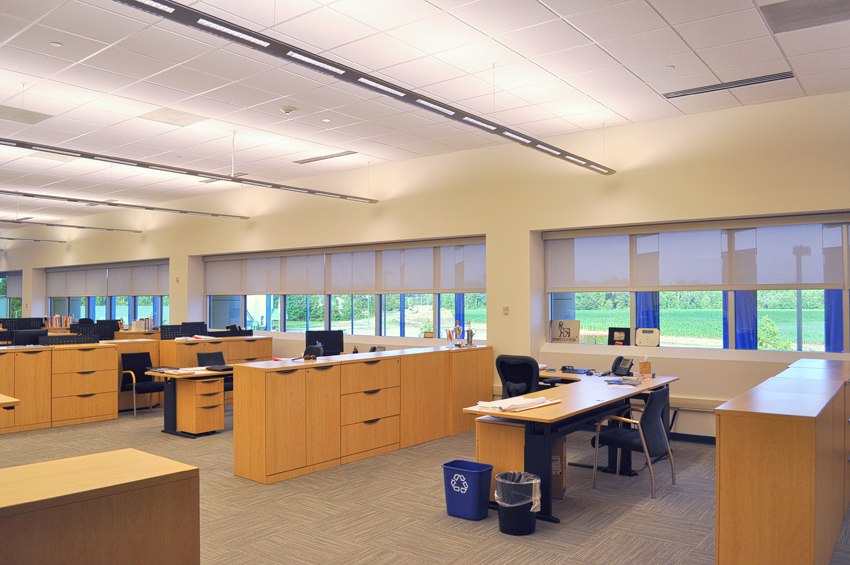
Photo: © Alex Krall
Shades create flexible solutions for interior, exterior, and dual-facade applications that allow a building manager and its occupants to control natural light, manage solar heat gain, reduce energy costs, and improve productivity and comfort.
How Shades Contribute to Whole Building Energy and Sustainability Benefits
Window shading solutions offer a frontline resolution to building energy concerns. Window shades, whether manual or motorized, reflect sunlight and heat, and reduce or eliminate glare. Shades create flexible solutions for interior, exterior, and dual-facade applications that allow building managers and occupants to control natural light, manage solar heat gain, reduce energy costs, and improve productivity and comfort.
Windows have several direct effects upon the indoor environment: its energy efficiency, thermal comfort, visual comfort, acoustic comfort, and indoor air quality (IAQ).
Windows play an important part in the electrical consumption of a building. While 71 percent of all lamps in the United States are installed in residential units, commercial building lighting is by far the largest consumer of energy and lumens (lm).2 Where windows can supplement or altogether replace artificial light with true daylight, the benefits are impressive. In an analysis of six case studies, an average lighting energy savings of 52 percent was reported due to high-performance daylighting systems.3
More daylight also means greater occupant health—access to natural daylight and the ability to maintain outward views is shown to improve mood and productivity. Daylighting in the winter brings in solar radiation to help heat the building.
However, uncontrolled daylighting can lead to critical building issues. Solar heat gain can account for up to 50 percent of a building’s energy cost, according to the U.S. Department of Energy. When solar heat gain accelerates beyond the control of heating, ventilation, and air-conditioning (HVAC) design, the building’s thermal comfort takes a hit. Thermal comfort affects the performance of office tasks. Temperatures that are either too high or too low deteriorate work performance. High indoor air temperatures also increase the prevalence of sick building syndrome, while IAQ deteriorates.4
The right shading solution can help reduce reliance on HVAC in the summer by reducing solar heat gain, and in the winter by helping a building to retain heat, particularly on cloudy days. The flexibility of shades is ideally suited to this dual-purpose role. Per ASHRAE guidelines, incorporation of automated shading systems allows for a reduction in size of HVAC equipment. Shades are an effective partner in energy conservation and utility cost-reduction strategies. By reflecting solar energy, shade fabrics reduce solar heat gain, lower energy costs, and improve comfort.
Unlike traditional window treatments that take an all-or-nothing approach to sun control, performance shade fabrics are versatile, allowing a certain percentage of light in and preserving the view to the outside, even while the shades are down. Duplex shade fabrics are designed to be uniquely applicable in capturing both energy and occupant benefits.
Selection of motorized solar shades allows for shading strategies to be automated and integrated with whole building automation systems. Shades can now partner with building management systems to actively optimize daylight harvesting strategies, for aesthetic and visual organization, to enhance building productivity, and to minimize exterior visual impact. Incorporating motorized shades as a part of daylighting strategies can also earn points toward environmental certification standards, including the WELL Building Standard and LEED. There are several LEED credits available for daylighting and views, where automated shades earn a project credit.
Leading shade manufacturers are members of the U.S. Green Building Council (USGBC) and maintain LEED-accredited professionals on staff to ensure that environmental and product goals for each project are met. Besides environmental credits from shading and automation, certified shade fabrics are also on the market, offering PVC-free, GREENGUARD Gold, and cradle-to-cradle designations.
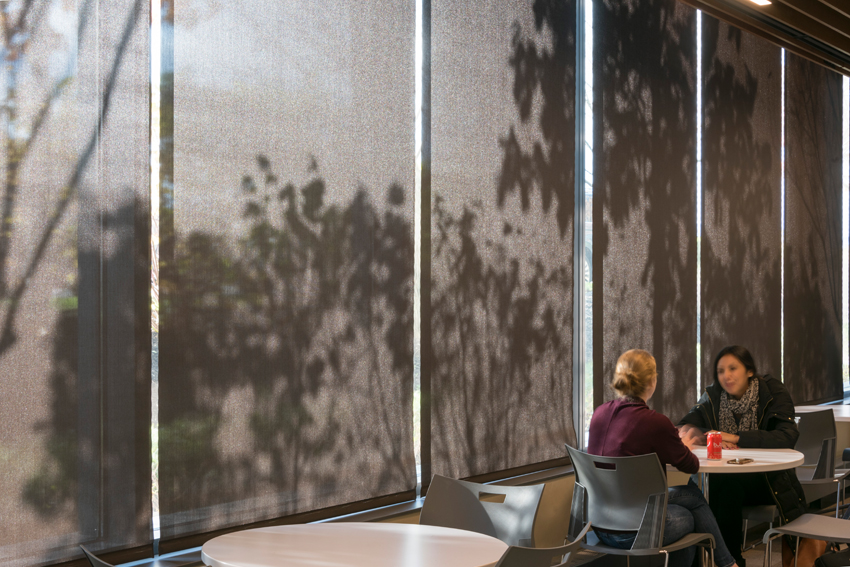
Photo courtesy of Draper Inc.
Productive buildings foster the best environment for their occupants. Shading strategies secure key occupant welfare benefits, such as visual and thermal comfort.
Harnessing Shades and Motorized Controls to Enhance Occupant Well-Being
Shading systems are traditionally presented, first and foremost, as a method to achieve energy cost savings by using natural light and solar heat gain control to lower utility bills and reduce the size of HVAC and lighting systems. While the impact of shading strategies on energy is demonstrable and more easily measurable, one of their greatest impacts is on occupant welfare, and this becomes a definitive advantage.
In modern commercial buildings, the largest amount of money spent annually on operation is invested in people. Wages and other workforce costs represent the biggest chunk of operating expenses, and it is in this area where shading solutions can have the greatest impact.
According to the Productive section of the WBDG, typical total life-cycle costs of private-sector buildings are $200 per square foot per year for salaries; $20 for amortized bricks/mortar cost; and $2 for energy.5 Based on these numbers, even a very small improvement in worker productivity and welfare will have a huge impact. “Buildings can be a more effective, exciting places to work, learn, and live by encouraging adaptability, improving comfort, supporting sense of community, and providing connections to the natural environment, natural light, and view,” the WBDG states.
The WBDG designates five basic design principles that are part of productive buildings:
- The design promotes health and well-being.
- The design accommodates the changing workplace.
- The design integrates technological tools.
- The design assures reliable systems and spaces.
- The design promotes comfortable environments.
If the majority of building expenses is related to occupants, increasing occupant comfort and productivity is vital, not only for the occupant but also for the building in the long term. How then can the design professional measure the success of various shading strategies? How can occupant welfare be measured numerically? A business’s productivity can be evaluated at a high level by dividing revenue (earnings before interest, taxes, depreciation, and amortization, or EBITDA) by the number of employees. In manufacturing, productivity is easily measured by dividing production output (widgets made) by production input (labor hours). In office environments, productivity can be much harder to measure. Researchers in occupant welfare and productivity frequently use metrics like absenteeism, employee satisfaction, and retention/turnover to gauge an effect on productivity.
Indoor environmental quality can be characterized by four main dimensions: thermal, visual, acoustic comfort, and IAQ. Using these factors as a guide, window shades have a verifiable impact on improving productivity and occupant welfare.

Photos courtesy of Draper Inc.
Visual stress is a crucial issue for commercial buildings. Shades create healthy levels of light for occupants while preserving views to the outside.
The Impact of Shades on Occupant Welfare: Preserving Visual Comfort
Paramount to occupant welfare is availability of natural light. The human body needs natural light to create enzymes and proteins for a healthy life.
A 2003 study by the California Energy Commission (CEC) found that daylight levels and ventilation rates had a statistically significant impact in several occupant welfare models tested.6 Indoor environmental conditions demonstrated a measurable relationship to changes in office worker performance.
Having an effective electric lighting system does not replace the human need for natural light. A 1994 study found a statistically significant improvement in job performance in offices with windows. The Center for Building Performance and Diagnostics at Carnegie Mellon University looked at the impact of daylighting on productivity and recorded 40 percent gains. Evidence also suggests that workers make fewer mistakes in environments with plenty of natural light.
Therefore, natural light—and the means of getting it into a building—becomes an essential part of designing a building, not just to save on energy but also for maximum occupant productivity. The full benefits of natural light, however, stretch beyond the light itself. Access to window views of the outside also gives workers a connection to nature, which has also been found to have an impact on mood, satisfaction, and performance. On average, major health complaints are between 20–25 percent lower for persons close to an exterior window versus those that work in the interior core of a building, without access to view and daylight.7 Access to windows and daylight resulted in a 15 percent reduced absenteeism.8 Office workers were found to perform 10–25 percent better on tests of mental function and memory recall when they had the best possible view versus those with no view.
However, the incorporation of more windows into building design can bring negative consequences for occupants too. CEC found that windows are perhaps one of the most complex aspects of the office environment. While they can provide an office with daylight, views, ventilation, and a communication conduit with the outside world, windows also create an avenue for thermal discomfort, glare, noise, and distractions in the workplace.
Glare and direct sun on workers’ eyes or workspaces makes it harder to perform basic work functions and actually lowers productivity.
According to the American Optometric Association, the National Institute for Occupational Safety and Health, the Illumination Engineering Society (IES), the Human Factors Society, General Electric Corp., and other authorities, the average office environment requires only 20–70 foot-candles (fc) of light to perform computer and computer/paper tasks. Yet, in stark contrast, most work sites measure 80–120 fc of light. Vision-related problems are reported by a majority—between 61–80 percent—of those who work on computers for 6 or more hours per day.
Visual stress on occupants is a crucial issue for commercial buildings. The Occupational Safety and Health Administration (OSHA) workplace guidelines recognize the debilitating effects of glare causing eye strain, tension, lower productivity, and loss of visual function on electronic screens. The 2003 CEC study showed that the greater the glare potential from primary view windows, the worse the office worker performance, decreasing productivity by 15–21 percent, all other things being equal.
If bright, glary lighting is present, occupants tend to squint their eyes, causing facial muscles to contract. Over the course of the day, this can lead to tension headaches, eyestrain, and visual fatigue.
Because of their unique characteristics, solar shades play an important role in balancing the benefits of daylight and outdoor views against the negative consequences from glare and visual strain.
The flexible characteristics available with solar shade applications help commercial spaces to resolve occupant discomfort from all types of glare, including direct, high contrast ratio, and reflective glare. When the sun is relatively low in the sky and aligns directly with a window elevation, shade fabric density alleviates the direct disk glare generated by the sun’s angle. High contrast ratio glare occurs when the area behind an occupant’s work surface is much brighter than the actual work surface. Shades resolve this contrast ratio by using darker color tones and avoiding colorways with white yarns. Reflective glare caused by a light or bright light source reflecting directly on a worksurface can be reduced by selecting a dark-colored shade fabric. Performance shade fabrics can reduce glare by 70–100 percent, based on color, openness factor, and building orientation, while preserving view through.
Including automated shading optimizes glare control and maximizes daylighting based on building orientation and exterior conditions. Sensors measure and balance exterior light levels with desk illuminance to precisely control the shades, allowing for mitigation of glare and permitting light adjustments, as necessary, to provide adequate work surface illumination.
Glare control during the day is a pivotal reason for window shade use. However, shades can also play a role when the sun goes down. Light pollution can disrupt ecosystems and have adverse health effects on people, animals, and plants. The best way to drastically reduce light pollution is with opaque fabrics. A LEED credit is available for automated shading systems that reduce a building’s nighttime visible light transmission (VLT) to less than 10 percent. The system must be automated/scheduled to qualify for this credit.
Since every building type, design, and location is different, there is no one-size-fits-all solution. There are many types of systems and fabrics that can be used. Whichever type of solution is required, having a system that can react according to the prevailing conditions is important. Local control can be retained to promote individual comfort; however, this can negate all of the other benefits of automation.

Photo: © Brett Drury, Architectural Photography
Solar shades absorb the energy at the perimeter of the building and, via radiation, allow the heat to rise directly up instead of affecting thermal comfort of people further inside the space and creating additional heat buildup by striking more surfaces. By reflecting solar energy away, rather than transmitting it into the building, shades deflect heat transmittance.
The Impact of Shades on Occupant Welfare: Maintaining Thermal Comfort
In addition to glare, thermal comfort contributes directly to job performance and productivity.
Indoor temperature is one of the most fundamental characteristics of the indoor environment. The indoor comfort level can be controlled with differing accuracy, depending on the building and its HVAC system.
Thermal conditions inside buildings can vary considerably over time, for example, as outdoor conditions change, and also spatially within buildings. Recent research conducted by a team from the Helsinki University of Technology and Lawrence Berkeley National Laboratory demonstrates that indoor temperature affects several human responses, including thermal comfort, perceived air quality, sick building syndrome symptoms, and performance in work.9 The results of multiple studies analyzed by the team showed an average relationship of 2 percent decrement in work performance per degree Celsius when the temperature is above 25 degrees Celsius. The Helsinki team reported that, in a large U.S. study, 50 percent of the subjects stated that they preferred a change in their thermal state, 38 percent of subjects in winter were dissatisfied with thermal conditions, and almost 50 percent of the thermal conditions during summer were outside of the thermal comfort zone.
Lawrence Berkley National Laboratory reported that 18.4 percent of complaints were classified as indoor environmental complaints in a dataset that was collected from 575 buildings in the United States. Of those, 77 percent of indoor environmental complaints were about conditions perceived as too hot or too cold.10
With a building’s thermal comfort falling between such a narrow ideal to maximize occupant welfare, preventing excessive heat gain and loss through windows becomes paramount. Energy from the sun is short wave and carries little heat. Heat is only produced when solar energy is absorbed by a surface and is then radiated as long-wave infrared (IR) energy. Once the solar energy has passed through the glass, it is primarily captured inside the building—especially if low-E2 glazing is used. At this point, it becomes an additional load for the HVAC system. To ensure well-being and productivity, the WBDG recommends a holistic design approach, including the use of solar shading products. Solar shades absorb the energy at the perimeter of the building and, via radiation, allow the heat to rise directly up instead of affecting thermal comfort of people inside the space and creating additional heat buildup by striking more surfaces.
By reflecting solar energy away, rather than transmitting it into the building, shades deflect heat transmittance. Therefore, window shades are an excellent way to stop sunlight from hitting interior surfaces and creating solar heat gain. They also stop sunlight from being absorbed directly by occupants and decreasing their thermal comfort. How successfully a shade combats heat gain is mostly due to the exterior fabric color. Generally, fabrics with a lighter exterior color reflect more solar energy than darker colors, meaning they are better at keeping out the heat. Notably, however, certain manufacturers have developed fabric technology treatments that allow even darker colors to reflect more of the sun’s rays.
The Impact of Shades on Occupant Welfare: Preserving Acoustic Comfort
Sound as a detriment to well-being is a recently scrutinized factor. Exposure to noise sources such as traffic and transportation have been shown to hinder the health and well-being of people in a number of different ways.
Built environments can harbor sounds that are distracting and disruptive to work or relaxation. Employee surveys show that acoustic problems are a leading source of dissatisfaction within the environmental conditions of an office. As acoustic comfort is determined, in part, by the physical properties and contents of environments, and recognizing that occupant welfare means that the indoor environment should be a place of comfort, WELL aims to shape spaces to mitigate unwanted indoor noise levels and reduce exterior noise intrusion to enhance social interaction, learning, satisfaction, and productivity. In 2019, the global commercial flooring company Interface released the results of “What’s That Sound?” This is a workplace study uncovering how sound and acoustics impact employees in business environments. The survey, conducted in partnership with Radius Global Market Research, reveals that noise negatively impacts a majority (69 percent) of global employees’ concentration levels, productivity, and creativity.
While shading systems are not a major part of an overall strategy to enhance acoustic well-being for occupants, they do have a role to play. Shade fabrics can be tested and rated with a noise reduction coefficient (NRC) value. Knowing an NRC value helps equip design professionals in choosing a fabric that will absorb sound in that range. For example, a shade fabric with an NRC of 0.60 will absorb 60 percent of the sound that hits the fabric, as long as the shade is deployed.
The Impact of Shades on Occupant Welfare: Enhancing Indoor Air Quality
The quality of the indoor environment needs to be a dominant design concern, as people spend approximately 90 percent of their time in enclosed spaces.11
While indoors, inhalation exposure to indoor air pollutants can lead to a variety of poor health and well-being outcomes. Health effects associated with exposure to indoor air pollutants can be short and long term, and can range in severity. Building materials, furnishings, fabrics, cleaning products, personal care products, and air fresheners can all emit volatile organic compounds (VOCs) or semi-volatile organic compounds (SVOCs) into the indoor environment. Outdoor air pollution can also influence indoor exposure.
CEC’s 2003 study found that indoor environmental conditions have a measurable relationship to changes in office worker performance. The combination of physical comfort conditions considered—illumination, view, ventilation, and temperature—typically accounted for 2–5 percent of variations in worker performance.
Achieving the goal of clean indoor air requires both professionals and building users to engage not just in the conversation but also in the implementation of adequate approaches. WELL recommends proper management of IAQ by eliminating individual sources of air pollution as well as through adequate design solutions and human behavior modification. Shades play an important role in IAQ. Not only do they provide view, proper illumination, and temperature modification, but carefully selected shade fabrics also ensure that no harmful off-gassing or VOCs will be emitted in the interior. Manufacturers offer a range of GREENGUARD Gold-certified fabrics to safeguard buildings as environmentally responsible, profitable, and healthy places to live and work.
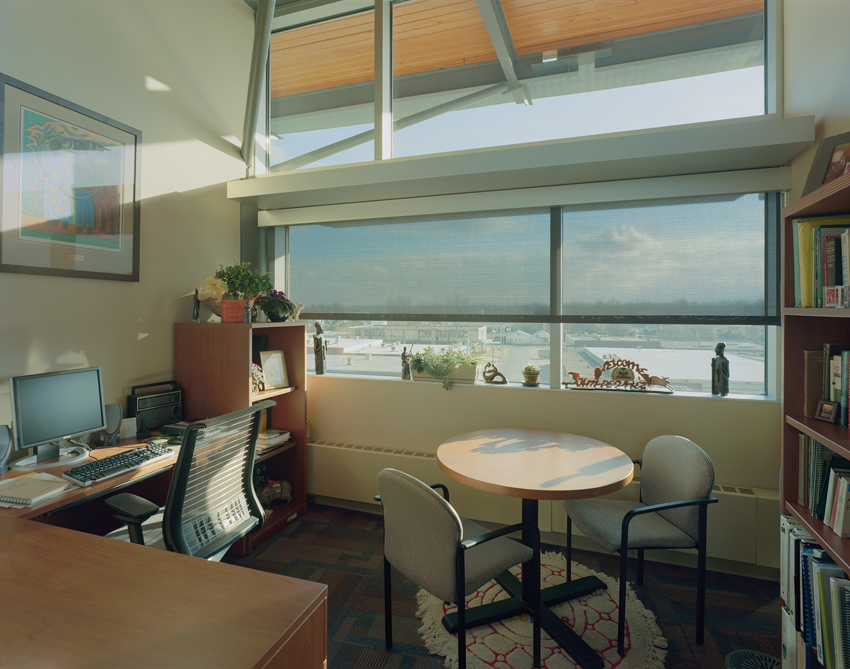
Photo: © Timothy Hursley
Window shades allowed the LEED Platinum-certified Heifer International headquarters building located in Little Rock, Arkansas, to maintain its designed efficiency while fostering occupant welfare.
Translating Occupant Welfare into Dollars and Sense
Supporting occupant productivity and well-being is a supreme design factor for the professional. Ensuring worker comfort against performance detractors, like glare and temperature fluctuations, protects the health, environment, and sustainability of a building and its users.
Often, to support the argument for effective solar-control solutions, their benefits need to be concretely communicated in terms of dollars. Because workforce costs are typically the biggest portion of a business’s operating expense, productivity is a big value driver for solar-control solutions.
In the average office building, more than 80 percent of the total operating expenses are salaries and personnel related costs.10 A “typical” office space floor plate of 24,300 rentable square feet yields 20,000 usable square feet. At an average of 175 square feet per employee, this translates into space for 114 employees. Using a conservative average salary estimate of $40,000 per employee with a 40 percent burden for payroll taxes and other associated benefits, this equals a total labor cost of $6,384,000 annually (114 x [$40,000 x 1.4] = 6,384,000). Therefore, every 1 percent gain in productivity equals a $63,840 benefit annually.
Using the latest research in welfare and energy benefits from shading solutions, what numerical returns on investment can be proven? For temperature control, WELL says that leading research indicates that employees perform 6 percent poorer when the office is overheated.
According to the CEC, glare can reduce productivity by up to 21 percent annually.
Solar shading solutions not only control natural light, reduce energy costs, and manage solar heat gain, but they also have a real cost/benefit return when they improve employee productivity and comfort. Even if their contribution is a small percentage, it is still a large benefit to the bottom line.
Properly Valuing Motorized Shading Systems
A motorized and automated system provides the fullest benefit for the investment in shading strategy for a relatively small impact on the overall project budget. Incorporating an automated control system maximizes the benefits from shades, safeguarding the highest levels of user comfort, glare minimization, and maximal energy savings. The added cost can be made up by improved productivity and, where applicable, smaller HVAC load. Unfortunately, shades are often among the last products to go into a building, and as a finish, their choices are often hampered by shortened budgets and last-minute value engineering. Despite the advances in shade technology, which have rendered motorization and automation as a fraction of shade cost, the industry perception remains that automation is expensive. Reverting to manual shades to save a few dollars in the short term hampers long-term occupant welfare and productivity, and may lead to retrofits down the road to ensure comfort and enhance energy savings.
“The reality is that automation is a relatively low cost add-on if you specify a good-performing motorization system,” notes Jeffrey Miller, manager of solar-control products for Draper Inc. While market perceptions exist that shade automation is expensive, the reality is drastically different—a design professional can effectively automate floor by floor, by elevation, or per tenant for a very small premium. “The decrease in expense is a big change in the past 5 to 10 years,” Miller says. “Ten years ago, the cost for automation could run up to four times the cost of the shades themselves; today, automation is now a fraction of the cost of shades.”
A seismic shift in technology, simplification, and reduction in the cost of components all combine to place automation within reach of most buildings.
Not only does automation guarantee efficiency and welfare strategies, it also helps buildings earn important credits on the road to various sustainability certifications, including LEED.
“We are anxious for designers to make this connection,” Miller says. “Do not skip out on an easy way to obtain LEED or other sustainability and wellness credits. With automation, you can take a building from LEED Silver to Gold, which makes a difference in marketability and lease rates.”
Automation also brings aesthetic value. Designers receive the added benefits of exterior management and visual organization of elevations. Fabric color has a visual impact on glass color and tint. Having shades across a facade at different stages of deployment looks disorganized. Choosing the right exterior color and automating shades ensures a uniform and positive appearance.

Photos: © Brett Drury, Architectural Photography
A seismic shift in technology, simplification, and reduction in the cost of components all combine to place automation within reach of most buildings.
Specification Notes for Motorized Shading Systems
When specifying motorized shades, some product considerations have to be made. These address hardware size and type, coupling, and product type.
There are three types of motorized shade controls: group, individual, and combined group and individual controls. Costs can be reduced by coupling shades and sharing motors, which also eases installation and setup. Intelligent motor systems can be designed where external controllers are not required. The motor itself keeps track of the solar shade’s position, rather than the controller, and can supply feedback to the central control system.
The complexity and ultimate cost of the motorized shade system depends on how large and flexible it needs to be. Where integration with existing automation is not desired, motorized shades can incorporate stand-alone automation based on local operation, time schedule operation, sun sensors, or sun-tracking data.
The Holistic Role of Shades In Efficiency And Occupant Well-Being
When seeking a finish option that maximizes both occupant welfare and building performance, what role can motorized shades play in a design? Solar shades create flexible solutions for interior, exterior, and dual-facade applications that allow building managers and occupants to control natural light, manage solar heat gain, reduce energy costs, and improve employee productivity and comfort. Amplified energy efficiency and increased occupant comfort are enhanced and secured by specifying automated solar shades.
End Notes
1Ander, Gregg D. “Windows and Glazing.” Whole Building Design Guide (WBDG). 11 November 2016. Web. 5 June 2020.
2“2010 U.S. Lighting Market Characterization.” U.S. Department of Energy. January 2012. Web. 5 June 2020.
3Loftness, Vivian et al. “Building Investment Decision Support (BIDS™).” 2004. Web. 9 June 2020.
4Seppanen, Olli et al. “Ventilation and performance in office work.” Lawrence Berkley National Laboratory. 1 July 2004. Web. 10 June 2020.
5WBDG Productive Committee. “Productive.” WBDG. 29 August 2018. Web. 5 June 2020.
6“Windows and Offices: A Study of Work Performance and the Indoor Environment.” California Energy Commission. October 2003. Web. 5 June 2020.
7Streitz, Norbert et al. Cooperative Buildings. Integrating Information, Organizations, and Architecture. Second International Workshop, CoBuild. 1–2 October 1999.
8Edwards, L. and Torcellini, P. “A Literature Review of the Effects of Natural Light on Building Occupants.” National Renewable Energy Laboratory. July 2002. Web. 5 June 2020.
9Seppanen, Olli et al. “Ventilation and performance in office work.” Lawrence Berkley National Laboratory. 1 July 2004. Web. 10 June 2020.
10Fisk, William et al. “Worker Performance and Ventilation: Analyses of Time-Series Data for a Group of Call-Center Workers.” Lawrence Berkley National Laboratory. 2002. Web. 10 June 2020.
11Zhang Y. Indoor Air Quality Engineering. CRC Press. 2004.
12Seppanen, Olli et al. “Ventilation and performance in office work.” Lawrence Berkley National Laboratory. 1 July 2004. Web. 10 June 2020.






















